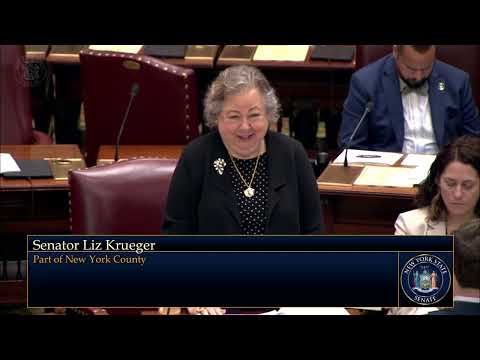
Testimony Before the New York State Division of Housing and Community Renewal Regarding the 2010 Housing Credit Qualified Allocation Plan on November 2, 2009
Liz Krueger
July 15, 2010
My name is Liz Krueger and I represent the 26th Senate District, which includes the East Side and Midtown areas of Manhattan.
I want to thank you for providing me with this opportunity to testify on the Division of Housing and Community Renewal’s (DHCR) proposed changes to the federal Low-Income Housing Credit Program Qualified Allocation Plan (QAP) and the New York State Low-Income Housing Credit Program. While I fully support the majority of changes in this year’s QAP, particularly the clarification of the Green and Energy Efficiency criteria and the addition of greater threshold requirements to the Green Building component, I have serious concerns about the proposed changes to the allocation of points for long-term affordability.
It is imperative that our state housing policies strongly encourage the development of permanently affordable housing. New York’s housing crisis has been severely exacerbated by the loss of tens of thousands of previously affordable homes constructed with state and federal funds. In recent years, we have witnessed the severe community upheaval and additional costs to government caused by the privatization of homes developed though the Mitchell-Lama, Section 8, tax credit, and other government programs which did not require permanent affordability. In order to prevent this pattern from repeating itself once again, our state and federal housing agencies must make the permanent affordability of housing a top priority when determining how funding and tax credits are distributed.
I know that long-term affordability in tax credit projects is also of great importance to DHCR, and this significance has been reflected in its recent tax credit awards. Therefore, I am surprised and troubled by the proposal in the 2010 QAP to reduce the number points awarded to developers for long-term affordability from seven to five points. I also am deeply concerned that the reduction in points awarded in this category will send a message to developers and the public that the importance of long-term affordability to the state is diminishing.
I am aware that the QAP points system requires that points be reallocated when new categories are added, and that changes in federal law require the state to award points for historic preservation. However, I believe DHCR has the ability to implement the new federal QAP requirements while also increasing the state’s commitment to long-term affordability. DHCR could accomplish this by eliminating the long-term affordability category as an incentive scoring category based on points, and making it a threshold requirement.
Making long-term affordability a threshold requirement would not only be a good housing policy, it would be also consistent with DHCR’s goals and policies. Since over 90% of DHCR tax credit projects are already developed with 50-year-or-greater affordability requirements, this change would not affect the ability of the state to allocate these tax credits. This change would codify the long-term affordability as part of a publicly-subsidized housing development for future administrations. An interesting example of another state which adopted a similar policy is that of California which made this change in the 1990s. California’s Tax Credit Allocation Committee requires a 55-year affordability term and has reported that there has not been push back from the development community nor difficulty allocating its credits. In 2008, demand for housing tax credits exceeded supply by approximately three to one.
DHCR could make this change by eliminating Section 2040.3(f) (5) and by taking the language formerly in that section and applying it to Section 2040.3(e)(17)(i) to read “the project will be a qualified low-income housing project for less than thirty years. In addition, the project will enter into an extended use agreement, which may include a commitment to convey ownership to a local non-profit organization, to operate the project as a qualified low-income housing project for a period of at least fifty years,” or other language which DHCR believes would effectively mandate a fifty-year regulatory period in which the project is operated according to tax credit compliance standards. This would also have the additional benefit of freeing up five points in the QAP which could be allocated to other categories which need more emphasis, such as the supportive housing category and the non-profit preference category.
Thank you for this opportunity to testify.
Share this Article or Press Release
Newsroom
Go to NewsroomTREES Act Passes Both Houses Of The Legislature
May 16, 2024



